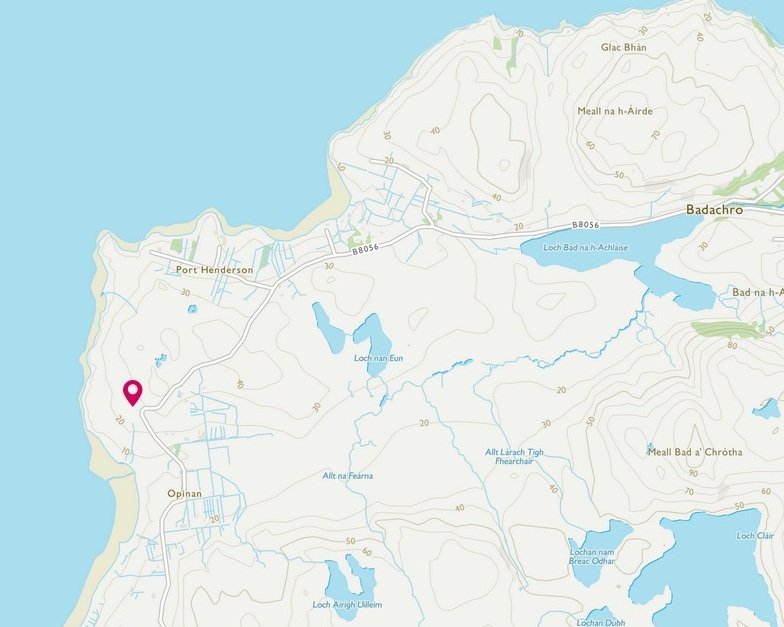Place-Names: Exploring the long history of the Gypsy Traveller community with the Gairloch area
June is Gypsy, Roma, Traveller History Month, and in celebration we’re exploring the long history of the Gypsy/Traveller community within the Gairloch area. Throughout this month you’ll hear about the families recorded within census records, memories from the 1950s, and related objects held within the Museum. But first, we’re discovering the local place-names which have Gypsy/Traveller connections…
Until recently, Gypsy/Travellers would have been common in rural locations such as Gairloch and the surrounding areas. As well as being skilled craftspeople who could make and mend metalware, baskets and horn objects, they also bought domestic items such as ceramics and sewing materials from towns and cities into the area, hawking (selling or swapping) them from door to door. Every Traveller family lived differently, but it was common to ‘overwinter’ somewhere in a house or large tent, giving the children a chance to go to school. Once the warmer months came, the family would begin to move to where there was work within farms and crofts, or the chance to sell or trade new items. Sometimes staying a few days, or sometimes months, some families might travel the same roads each year, whilst others went wherever they wished. During summer it was common for families to stay in a tent known as a bow tent. Although the style and materials vary from family to family, as well as for how long it was to be lived in, they were generally made from lengths of willow or hazel, a large waterproof canvas which was moved from place to place and reused by the family, and stones found nearby to hold the canvas down. These materials left no trace on the landscape, but within the Gairloch area the presence of Gypsy/Travellers can be found within place-names, many of which were documented by local Gaelic scholar Roy Wentworth.
Historically, a Gypsy/Traveller within the Highlands would have been known as a ceàrd, pronounced ky-aart, which translates to a smith, reference to the community’s skilled craftsmen. Within the Gairloch area however Roy spells it as ceàird which reflects variations within the dialect. The following place-names have been collected from Roy Wentworth’s dictionary and other local sources with the help of Nevis Hulme.
Tobair nan Ceàirdidhean, the Travellers’ Pool, NG 7430 7109
Tobair nan Ceàirdidhean, the Travellers’ Pool
This is a pool or deeper part of the river Allt Ùmh ’Chlèibh in South Erradale, just above Droichid Ùmh Chlèibh, the bridge over the burn. Travellers used to camp nearby and drew water for themselves and their horses from this pool.
Làthrach nan Ceàirdidhean, the Travellers’ stance, NG 7438 7292
Làthrach nan Ceàirdidhean, the Travellers’ stance
A flattish, sandy area to the west of the sharp bend on the road where it climbs An t-Achadh just outside of Opinan, where Travellers would camp. The usual spelling of làthrach is làrach and it more usually translates as site.
Poll nan Ceàirdidhean, the Travellers’ pool, NG 8199 7233
Poll nan Ceàirdidhean, the Travellers’ pool
A pool in the River Kerry, beside which Gypsy/Travellers would camp. You can hear more about this camp later on in the month.
Glac nan Ceàird, the Travellers’ hollow, NH 0243 6098
Glac nan Ceàird, the Travellers’ hollow
A sheltered hollow on the Kinlochewe to Torridon road to the north of Cromasaig. It lies on the west side of the road immediately beside Allt a’ Chùirn and is enclosed by this burn on the south, by the road on the east and by steep banks on the north and west. It is now fairly densely wooded with birch. This used to be a favourite spot for the Travellers to camp, though many have wondered how in a spot so sheltered and full of vegetation the people could bear the midges there in summer.
Làthrach nan Ceàirdidhean, the Travellers’ stance, NH 0211 6279
Làthrach nan Ceàirdidhean, the Travellers’ stance
A small area just to the southwest of the Kinlochewe to Gairloch road, at the foot of the path that runs up the hill beside Allt na Sguabaig. Formerly used by travelling people for camping, it is now a car park for walkers on the path. There was formerly a stance about a mile northwest at Taagan but one night the Travellers saw something there they believed was supernatural which frightened them, and as a result moved to the foot of the Allt na Sguabaig path.
Cnoc nan Ceàirdidhean, The Traveller’s knoll
Cnoc nan Ceàirdidhean, The Traveller’s knoll
The exact location of this spot is unknown, but it is thought to be on the seaward side of the road, near the area which is now Fasaig.
With the location of so many camping areas preserved through place-names, it’s clear that the Gypsy/Traveller community were frequent and respected visitors to the area. In our next post we’ll be looking at information from census records which places families in these areas between 1841 and 1911.
Gairloch Museum recently relocated to a former nuclear bunker in the centre of Gairloch in Wester Ross, winning ArtFundUK’s Museum of the Year 2020. The museum tells the story of the people and landscape of Gairloch and the surrounding area from Mesolithic man to crofting communities. If you or your family have any memories of Gypsy/Travellers within the area, including photographs or objects, we’d love to hear from you at info@gairlochmuseum.org.







